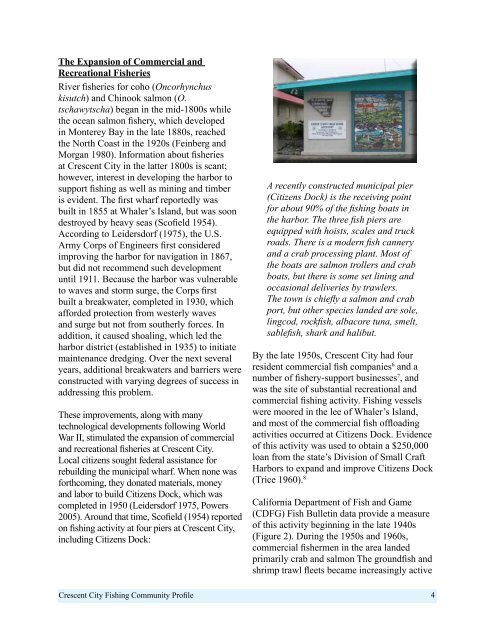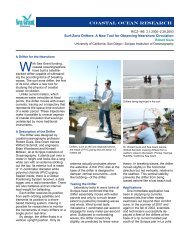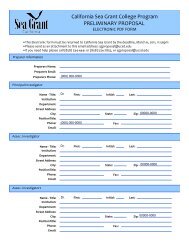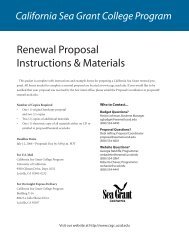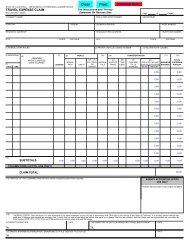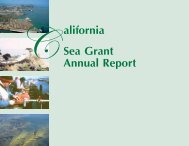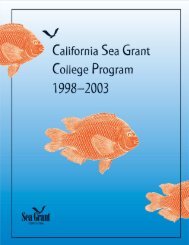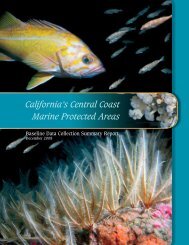Crescent City Profile - California Sea Grant
Crescent City Profile - California Sea Grant
Crescent City Profile - California Sea Grant
- No tags were found...
Create successful ePaper yourself
Turn your PDF publications into a flip-book with our unique Google optimized e-Paper software.
The Expansion of Commercial andRecreational FisheriesRiver fisheries for coho (Oncorhynchuskisutch) and Chinook salmon (O.tschawytscha) began in the mid-1800s whilethe ocean salmon fishery, which developedin Monterey Bay in the late 1880s, reachedthe North Coast in the 1920s (Feinberg andMorgan 1980). Information about fisheriesat <strong>Crescent</strong> <strong>City</strong> in the latter 1800s is scant;however, interest in developing the harbor tosupport fishing as well as mining and timberis evident. The first wharf reportedly wasbuilt in 1855 at Whaler’s Island, but was soondestroyed by heavy seas (Scofield 1954).According to Leidersdorf (1975), the U.S.Army Corps of Engineers first consideredimproving the harbor for navigation in 1867,but did not recommend such developmentuntil 1911. Because the harbor was vulnerableto waves and storm surge, the Corps firstbuilt a breakwater, completed in 1930, whichafforded protection from westerly wavesand surge but not from southerly forces. Inaddition, it caused shoaling, which led theharbor district (established in 1935) to initiatemaintenance dredging. Over the next severalyears, additional breakwaters and barriers wereconstructed with varying degrees of success inaddressing this problem.These improvements, along with manytechnological developments following WorldWar II, stimulated the expansion of commercialand recreational fisheries at <strong>Crescent</strong> <strong>City</strong>.Local citizens sought federal assistance forrebuilding the municipal wharf. When none wasforthcoming, they donated materials, moneyand labor to build Citizens Dock, which wascompleted in 1950 (Leidersdorf 1975, Powers2005). Around that time, Scofield (1954) reportedon fishing activity at four piers at <strong>Crescent</strong> <strong>City</strong>,including Citizens Dock:A recently constructed municipal pier(Citizens Dock) is the receiving pointfor about 90% of the fishing boats inthe harbor. The three fish piers areequipped with hoists, scales and truckroads. There is a modern fish canneryand a crab processing plant. Most ofthe boats are salmon trollers and crabboats, but there is some set lining andoccasional deliveries by trawlers.The town is chiefly a salmon and crabport, but other species landed are sole,lingcod, rockfish, albacore tuna, smelt,sablefish, shark and halibut.By the late 1950s, <strong>Crescent</strong> <strong>City</strong> had fourresident commercial fish companies 6 and anumber of fishery-support businesses 7 , andwas the site of substantial recreational andcommercial fishing activity. Fishing vesselswere moored in the lee of Whaler’s Island,and most of the commercial fish offloadingactivities occurred at Citizens Dock. Evidenceof this activity was used to obtain a $250,000loan from the state’s Division of Small CraftHarbors to expand and improve Citizens Dock(Trice 1960). 8<strong>California</strong> Department of Fish and Game(CDFG) Fish Bulletin data provide a measureof this activity beginning in the late 1940s(Figure 2). During the 1950s and 1960s,commercial fishermen in the area landedprimarily crab and salmon The groundfish andshrimp trawl fleets became increasingly active<strong>Crescent</strong> <strong>City</strong> Fishing Community <strong>Profile</strong> 4


